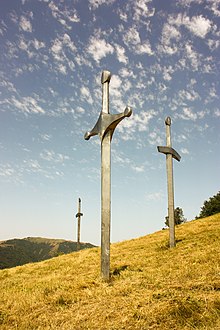| Battle of Didgori | |||||||
|---|---|---|---|---|---|---|---|
| Part of the Georgian–Seljuk wars | |||||||
 Didgori monument | |||||||
| |||||||
| Belligerents | |||||||
|
| |||||||
| Commanders and leaders | |||||||
|
Ilghazi (WIA) Tughril bin Muhammad[5] Dubays II |
David IV Prince Demetrius | ||||||
| Strength | |||||||
|
Modern estimates: Medieval Christian sources: Medieval Arab sources 30,000[18] |
Total: 55,600 (Georgian sources)[17][19]
| ||||||
Location of Didgori valley in Georgia with present-day administrative borders. | |||||||
The Battle of Didgori (Georgian: დიდგორის ბრძოლა, romanized: didgoris brdzola) was fought between the armies of the Kingdom of Georgia and the Seljuk Empire at the narrow place of Didgori, 40 km west of Tbilisi, on August 12, 1121. The large Muslim army, under the command of Ilghazi, was unable to maneuver and suffered a devastating defeat due to King David IV's effective military tactics.
The battle at Didgori was the culmination of the entire Georgian–Seljuk wars and led to the Georgians' reconquest of Tbilisi in 1122. Soon after that David moved the capital from Kutaisi to Tbilisi. The victory at Didgori inaugurated the medieval Georgian Golden Age and is celebrated in The Georgian Chronicles as a (Georgian: ძლევაჲ საკვირველი dzlevay sak'virveli lit. the "miraculous victory"). Modern Georgians continue to remember the event as an annual August 12 festival known as Didgoroba ("[the day] of Didgori").[22][23]
- ^ United States Congress. House Select Committee on Communist Aggression (1954). Investigation of Communist takeover and occupation of the non-Russian nations of the U.S.S.R. University of Michigan Library. p. 180.
- ^ Khazanov, Anatoly M.; Wink, Andre (2001). Nomads in the Sedentary World. Routledge. p. 47.
- ^ Rogers, Clifford J.; DeVries, Kelly; France, John (June 19, 2014). Journal of Medieval Military History: Volume XII. Boydell Press. p. 88.
- ^ Coene, Frederik (2011). The Caucasus – An Introduction (Routledge Contemporary Russia and Eastern Europe) (1st ed.). Routledge. p. 113.
- ^ Mikaberidze 2015, p. 253.
- ^ Rayfield, Donald (2012). Edge of Empires: A History of Georgia. Reaktion Books. p. 92.
- ^ Prokhorov, Aleksandr Mikhaĭlovich (1973). Great Soviet Encyclopedia, Volume 8. Macmillan. p. 215.
- ^ Baumer, Christoph (2018). History of Central Asia, The: 4-volume set (The History of Central Asia). I.B. Tauris. p. 74.
- ^ Fähnrich, Heinz (2010). Geschichte Georgiens (Handbook of Oriental Studies. Section 8 Uralic & Central Asi) (German ed.). Brill. p. 199.
- ^ Mikaberidze 2015, p. 263.
- ^ Lordkipanidze, Mariam (1987). Georgia in the 11th–12th Centuries (1st ed.). Ganatleba Publishers. p. 98.
- ^ Murray, Allan V. (2006). The Crusades: An Encyclopedia 4 Volume Set. ABC-CLIO. p. 357.
- ^ Osman Turan, Selçuklular Zamanında Türkiye, İstanbul, 2013, p. 191.
- ^ Sevim, “Artuk Oğlu İlgazi”, p. 684; Sevim- Merçil, Selçuklu Devletleri Tarihi, p. 235.
- ^ Kırzıoğlu, Yukarı-Kür ve Çoruk Boyları’nda Kıpçaklar, p. 117.
- ^ Mikaberidze, Alexander. Conflict And Conquest In The Islamic World. Print. p. 276.
- ^ a b Alexander Mikaberidze, Miraculous Victory:’ Battle of Didgori, 1121, Published: May 14, 2008;" The size of the Muslim army is still a matter of debate with numbers ranging from a fantastic 800,000 men (“Bella Antiochena”, Galterii Cancelarii), 600,000 Turks (Matthew of Edessa) to 400,000 (Smbat Sparapet’s Chronicle) while the estimates of modern Georgian historians vary between 100,000–250,000 men."[1] Archived 2017-07-18 at the Wayback Machine
- ^ Ibn al-Athir, Al-Kāmil fī al-tārīkh (الكامل في التاريخ): "The Complete History"; vol: 10, p. 450
- ^ "დიდგორის ომის მიმდინარეობის ეტაპები". www.ufali.ge. Archived from the original on 2022-07-02. Retrieved 2021-04-28.
- ^ a b Смбат Спарапет / Летопись / пер. А. Г. Галстяна – Ер. Изд-во «Айастан». 1974 г. Царь Грузии Давид, сын Декая, сын Багарата, сын Георге, собрал все своё войско, пригласил на помощь также 40000 кипчаков, 18000 аланов, 10000 армян, 500 франков, людей храбрых и воинственных. Вот с таким количеством людей он (Давид) выступил в бой. Это был страшный бой. С божьей помощью победили христиане. Они истребили свыше 400000 и взяли в плен 50000 человек. Султан Мелек и Хази позорно обратились в бегство, а Давид победоносно и радостно возвратился обратно
- ^ Ronald Grigor Suny / The Making of the Georgian Nation / Indiana University Press, 1994. p. 36 (418). ISBN 978-0253209153 On August 12, 1121, the Georgians and their Armenian, Qipchak, Osetin, and Shirvan allies advanced and attacked the Muslims unexpectedly near Didgori, achieving what in Georgian history is known as dzlevai sakvir- veli, the "wonderful victory."
- ^ Suny, Ronald Grigor (1994). The Making of the Georgian Nation. Indiana University Press. p. 36. ISBN 0-253-20915-3.
- ^ Virgil, et al. Georgica. Heidelberg: C. Winter, 1985. Print. [ISBN missing]
